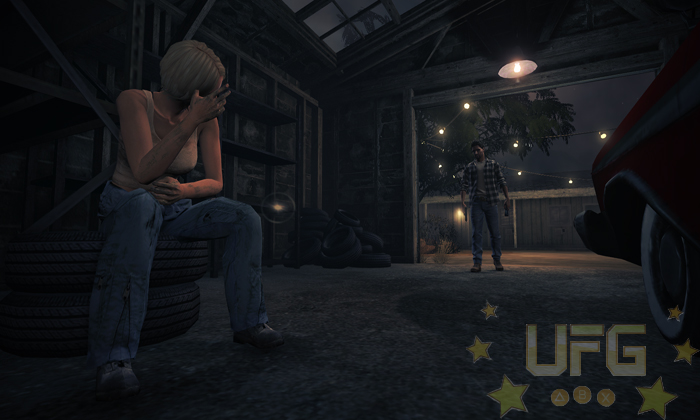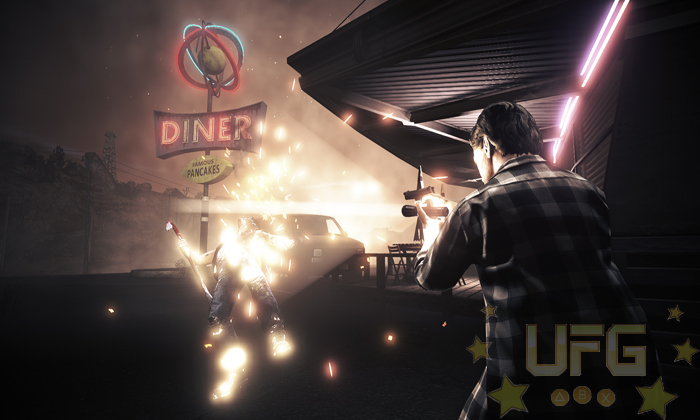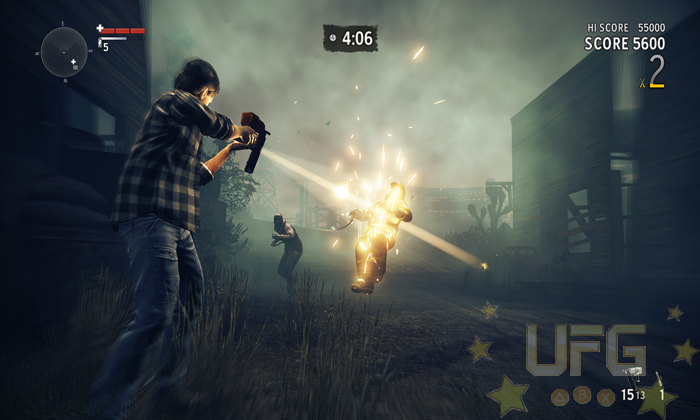Alan Wake’s American Nightmare
After the creation of the highly successful and critcally acclaimed debut, one would hope that the Alan Wake series would become one of Microsoft’s blockbuster franchises. Naturally, fans of the first game have been eagerly waiting for Remedy to announce the sequel. While they have stated that there is going to be an Alan Wake 2, Remedy’s plans for the series were…a bit different than what gamers expected. Instead of a full fledged sequel, what we got was a stand alone XBLA title featuring Alan. As one might expect, fans weren’t too pleased and wanted to know if it was going to be worth their time. I’ll say this, even though Alan Wake’s American Nightmare is not the sequel we were looking for, it is definitely worth a look!
Even though American Nightmare isn’t a direct sequel to the first Alan Wake, it does take place after the events of the first game. The game opens with Barry, Alan’s manager and friend, sleeping in front of his TV. As the camera pans over, we see that the TV is showing an episode of Night Springs, a show similar to the Twilight Zone that Alan wrote for. A narrator explains that Alan has been chasing his evil doppelganger named Mr. Scratch. During a confrontation with Mr. Scratch Alan is engulfed by darkness, only to wake up in the small town of Night Springs. This is where Alan’s interesting, yet confusing story starts and gamers regain control of said protagonist.
For those who remember the first game, there is another dimension or world that is close to ours. A ghastly entity called the Dark Presence (or Darkness) resides there with the power to corrupt anything it comes in contact with. Some people in our world have the ability to tap into that other world by using their creative talents to act as a bridge. When this happens the worlds temporally overlap, allowing that same person to transfer realities. It only works in places where the vale between our world and this other one is thin though. In the first game we found out that Alan was one of those individuals who could change reality with his writings. The Dark Presence found out as well and kidnapped Alan’s wife. Its intention was to force Alan to write a story that would alter reality so it could escape its world and be free in ours. If Alan got out of line it would send Taken, humans possessed with darkness, to attack him. Alan was able to outsmart the Darkness and free his wife. Unfortunately in doing so he ended up trapped in that alternate world. The two follow up episodes (The Signal and The Writer) showcase Alan trying to escape this dark world while battling back an evil version of himself. This is where we come in, as Alan confronts his evil self and ends up in Night Springs.
Still with me? Good. The reason I wanted to point these things out is that…well, it would be hard to follow what’s going on without some type of story summary. I mean, I’ve played through American Nightmare in its entirety and I still have questions (more on that later). As American Nightmare goes on, Alan is able to put clues together to figure out what’s going on. Not to give too much away, it seems that Mr. Scratch can jump into the Night Spring show from our world and vice versa at will. The reason he can do this is because Alan is trapped and is somehow keeping the door between both worlds open. Mr. Scratch has to keep Alan in this episode of the show in order to live in our world. But, just like in the first game if Alan can find his script from the show, he can alter reality and free himself. What follows is a hectic run through a television show, gunfights in the dark, and creepiness galore.
Moving from the story to the gameplay for a bit, things are a little different this time around. American Nightmare plays more like an action game than a survival horror title. That doesn’t mean you won’t be scared at times. Enemies will spawn in the environment and will aggressively hunt Alan. What makes them dangerous is that while you’re trying to fight off attackers other enemies will try to flank you, attacking from behind. They’re really good at it too. Remedy did a fine job making the Taken act life-like; the way they move, closing in from different directions, you’d swear they really existed as apposed to just being gaming AI. This allows for a scare or two in an otherwise action title. Seeing a huge guy with an axe pop up from behind easily freaked me out. Thank goodness there is a dodge feature. Tapping the run button right when an enemy attacks slows the game down, allowing Alan to narrowly escape getting hit. This mechanic is a life saver as it only takes a few hits for Alan to kick the bucket.
Just like in the first game, the combat revolves around using light to fight back the darkness. In order to put the Taken down, you have to use bright light to remove the darkness protecting them. Once it’s gone a couple bullets will stop their advances. Running to a street light will not only fill your life bar, it will give you a brief respite from your attackers. Flares and flash bangs will help clear a crowd of Taken trying to surround you. There are a decent amount of weapons for Alan to use such as shotguns, a flare gun, rifles and a cross bow. However, your main weapon against your enemies is light. This constant struggle makes for some interesting fights; I never got bored when it came to defending myself.
Going back to the story, I think that the writers were trying very hard to write a good mystery. So much so, that they ended up hurting Alan’s narrative. You see, there is an overwhelming need to “just go with it” when it comes to the events in American Nightmare. Take Mr. Scratch. He is the evil version of Alan, whom all of the characters in the game have met already. When Alan shows up in Night Springs, they all believe that he is Mr. Scratch. If that’s the case, why are they so willing to trust Alan? He has no proof (other than the fact that he doesn’t act crazy) that he is who he says he is and yet, everyone trusts him almost immediately. Then there is the notion that Alan is stuck in a TV show. During the game you’ll be able to hear radio broadcasts from the real world. A disc jockey will interview your old friend Barry about his current clients and your disappearance. If you keep listening to the show you’ll end up hearing from Alan’s wife. She will talk about a project she has been working on with Serena Valdivia, a character from Night Springs. Wait…what? If we are listening to real world broadcasts, why is a character from the show in the real world? And why doesn’t anyone think this is odd? Another confusing element of the story was in the finding of Alan’s scripts or writings for the show. Gamers will have to backtrack a bit in American Nightmare and when they do, they’ll stumble onto these writings. Again, without giving too much away, it seems that the longer Alan goes through the motions of the show, the more writings he can find that allow him to alter reality. My question is…why? Why does he slowly get an advantage over Mr. Scratch without the help of any outside force? It just doesn’t make sense. Mr. Scratch boasts about taking over his real life, yet the longer he keeps Alan trapped the more he is sabotaging himself. Really?
While my confusion didn’t deter me from continued play, it did hinder my enjoyment of the story. Which is really sad because there is a lot to like here; Mr. Scratch’s snuff-like films used to taunt Alan is a disturbingly awesome story element. With that being said, everything else rocked. The combat is fun, the campaign moves at a good pace, and it’s good in the sound department and visually pleasing. It even sports a new game mode called Fight till Dawn! Similar to other “horde” modes, it puts Alan against increasingly difficult waves of enemies. If you make it to dawn (a match lasts ten minutes) then you are scored based on your performance. It’s a challenging diversion from the main game that doesn’t feel like it was added as an afterthought, like many bonus game modes. Good stuff!
All and all, there might be hiccups in your enjoyment due to the story. That said, this title will definitely please fans and new comers alike!
Gameplay:
7
Alan Wake’s American Nightmare is fun to play. I just wish the story was better written.
Graphics:
9
Remedy did a great job with the visuals. Only a few stiff looking NPC’s hurt this score.
Sound:
9
Everything sounded pretty good.
What's New:
5
There wasn’t a whole lot that was new to the genre here. Being able to change reality is interesting though.
Replay Value:
8
There are collectibles in the form of Alan’s writings and weapons for the Fight till Dawn mode. Then there is the Fight till Dawn mode itself. Basically, you have good reason to replay American Nightmare!
Final Score:
7.6




